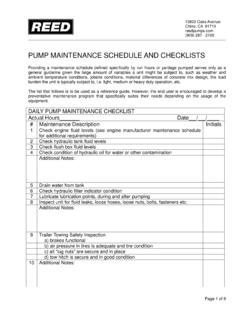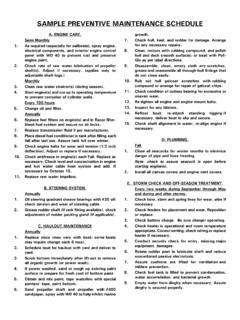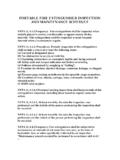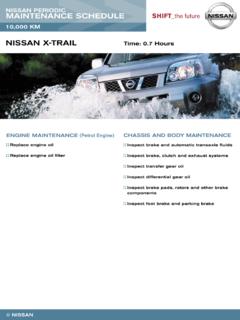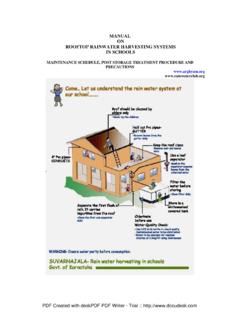Transcription of Maintenance Schedule Approval Policy and Procedures Manual
1 TP 13094E. (revised 06/2006). Civil Aviation Maintenance Schedule Approval Policy and Procedures Manual June 2006. REVISION 3. TC-1001769. *TC-1001769*. Her Majesty the Queen in Right of Canada, represented by the Minister of Transport (1998). Permission is granted by the Department of Transport, Canada, to copy and/or reproduce the contents of this publication in whole or in part provided that full acknowledgment is given to the Department of Transport, Canada, and that the material be accurately reproduced. While use of this material has been authorized, the Department of Transport, Canada, shall not be responsible for the manner in which the information is presented, nor for any interpretations thereof. TP13094E. (06/2006). TC-1001769. FOREWORD. This Manual has been prepared for the guidance of regional and industry personnel.
2 It contains information regarding the philosophy, development and Approval of aircraft Maintenance schedules. This document may be obtained by contacting a Transport Canada Centre. Original signed by Sherritt Director, Aircraft Maintenance and Manufacturing i This page intentionally left blank ii Table of Contents CHAPTER 1 ..1. Introduction ..1. 1 PURPOSE ..1. 2 REFERENCE MATERIAL ..1. 3 APPLICABILITY ..1. 4 CHAPTER 2 ..3. Schedule Development ..3. 5 GENERAL ..3. 6 7 SMALL AIRCRAFT 8 LARGE AIRCRAFT SCHEDULES ..4. 9 Schedule 10 TOLERANCES ..8. CHAPTER 3 ..9. Approval ..9. 11 GENERAL ..9. 12 STD 625, APPENDIX D, Approval ..9. 13 Schedule 14 ADMINISTRATIVE Procedures ..11. APPENDIX Form 24-0055A Small Aircraft Maintenance Schedule Approval ..12. APPENDIX Form 24-0055B Large Aircraft Maintenance Schedule APPENDIX Form 24-0055C Maintenance Schedule Amendment iii This page intentionally left blank iv CHAPTER 1.
3 Introduction 1 PURPOSE. This document provides guidance to headquarters, regional and industry personnel in the development and Approval of aircraft Maintenance schedules, including some, but not all of the means by which such schedules can be amended. 2 REFERENCE MATERIAL. This Policy and Procedures Manual should be used in conjunction with the following documents. CAR 406, Division IV. Personnel Licensing and Training Standards - Flight Training Units, STD 426, Division IV. CAR 605, Division III. Operating and Flight Rules Standards - Aircraft Equipment and Maintenance Standard, STD 625, Appendices B , C and D . CAR Part VII. Airworthiness Manual Advisory - Reliability Monitoring Programs (TP) 13850 Scheduled Maintenance Instruction Development Processes http://tcinfo/CivilAviation/ Maintenance / AARPC/ 3 APPLICABILITY.
4 The Procedures described herein may be applied to any aircraft, but are primarily intended for: aircraft operated by flight training units under CAR 406;. aircraft operated commercially under CAR Part VII;. pressurized turbine powered aircraft;. large aircraft; and airships. 4 BACKGROUND. Certain classes of aircraft (essentially those described in the applicability section). must be maintained in accordance with a Maintenance Schedule that has been approved by the Minister for the use of the particular operator. This document must contain details of all scheduled Maintenance to be performed, including inspections, overhauls, replacements, operational checks, lubrication, etc. The minimum contents of such a Schedule are outlined in STD 625, Appendices B, C and D. 1. This page intentionally left blank 2.
5 CHAPTER 2. Schedule Development 5 GENERAL. Transport Canada must first approve the initial Maintenance Schedule . Similarly, all amendments to the Schedule must also be approved, unless the operator's approved Maintenance Control Manual (MCM) includes Procedures for incorporating changes solely on the basis of the operator's own analysis. The operator must ensure that the tasks listed in the Maintenance Schedule are completed within the intervals specified. In addition to addressing all tasks arising out of the initial analysis of the aircraft's Maintenance Significant Items (MSI) all Maintenance schedules must include any additional items necessary to ensure compliance with Airworthiness Limitations such as component life limits, etc. The Schedule must take into account the aircraft's operational role, in particular the need for compliance with operational requirements such as those for Instrument Flight Rules, Extended Range Operations, Category II & III approach minima and operation with Reduced Vertical Separation.
6 The Schedule must also address any Maintenance requirements resulting from modifications or repairs, particularly major changes authorized by Supplemental Type Certificates, Limited Supplemental Type Certificates or Repair Design Approvals. Information Note: The operational role of the aircraft may have a significant effect on the Maintenance Schedule , for example: Aircraft engaged in agricultural operations may be authorized to operate at increased take off weights, or carry corrosive materials etc Pre-flight walk around checks performed by flight crew or daily and pre-departure checks intended to be performed by unlicensed personnel, need not form part of the approved Maintenance Schedule . These tasks should be addressed in other sections of the appropriate Maintenance control Manual , or in the case of private aircraft, will be performed at the discretion of the operator.
7 Similarly, compliance with Airworthiness Directives need not be included in the Maintenance Schedule , but must be managed directly by the operator, using a control system appropriate to the operation concerned. Except where specifically authorized otherwise in the operator's MCM, Transport Canada must approve all Maintenance Schedule amendments that relate to changes in the aircraft's operational role, deletion of tasks, increase in task intervals, or any other significant changes. Prior Approval is not required for the addition of tasks or reductions of task intervals, however the operator must notify Transport Canada of such changes at the earliest convenient opportunity. In the interests of standardization, and to simplify the Approval process, Transport Canada has developed documents to identify approved Maintenance schedules.
8 These documents are referred to throughout this document, and samples are provided in the appendices. Equivalent locally produced or computer generated documents may be accepted in lieu, provided they conform to the basic structure and content of the Transport Canada documents. 3. 6 APPLICATION. Application for Approval of a Maintenance Schedule must be submitted in accordance with STD 625 Appendix D. To simplify the process for operators of small aircraft, the Schedule may be based upon the applicable items contained in the list provided in STD 625 Appendix B, supplemented by the applicable out of phase requirements of STD 625 Appendix C. Approval of small aircraft and Balloon schedules is accomplished though the use of Appendix A of this document. Approval of all other schedules is by means of Appendix B of this document.
9 7 SMALL AIRCRAFT SCHEDULES. Operators of small aircraft should submit to Transport Canada a completed Maintenance Schedule Approval (Appendix A) in duplicate, containing or referencing the applicable Maintenance schedules, and make the Schedule available for review. If the Schedule is approved in accordance with STD 625 Appendix B, Part 1, the tasks listed must be performed at intervals not exceeding 100 hours air time or 12 months, whichever occurs first. The Schedule may include additional tasks performed at greater intervals, provided that all the items addressed in Appendix B Part 1 are inspected at intervals no greater than 100 hours air time or 12. months. The Schedule may be a progressive type Schedule , whereby not all of the tasks need be performed at the same time, provided that no item listed in Appendix B Part 1 is inspected less frequently than 100 hours air time or 12.
10 Months. The operator of a small aircraft may choose to seek Approval for a Maintenance Schedule in accordance with STD 625, Appendix D. In such cases, application should be made using Appendix A to this document and the Procedures specified in paragraph 8 below would apply. 8 LARGE AIRCRAFT SCHEDULES. When complying with the requirements of STD 625 Appendix D, the proposed Maintenance Schedule must be based on one of the following sources;. Maintenance Review Board (MRB) reports. Schedules based on an MRB report must include all the tasks listed in the report, plus any additional tasks arising from the role in which the aircraft is to be employed or the environment in which it is to be operated. The intervals between tasks specified in the MRB should be regarded as the maximum intervals for the operator's initial Schedule , and may be adjusted downward if the operation is in any way non- standard.
